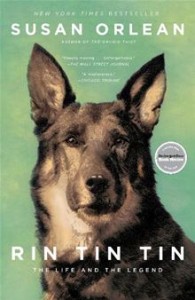Rin Tin Tin: The Life and the Legend
By Susan Orlean
Published by Simon & Schuster
324 pages, $29.99
BY JESSICA LAMPARD
Susan Orlean published her first book Saturday Night in 1990, and has written for the New Yorker since 1992. She is the author of nine non-fiction books, including her 1998 bestseller The Orchid Thief.
With her latest book, Rin Tin Tin: The Life and the Legend, Orlean uses a potent mix of historical facts, description, and personal details to illuminate the reasons why movie-star dog Rin Tin Tin has “managed to linger in the minds of so many people for so long, when so much else shines for a moment only and then finally fades away.”
After all, the original Rin Tin Tin died back in the 1920s after a regular-length romp on earth. Yet his legacy still endures, even after many of his movies have been lost and his television show cancelled.
The book is full of factual details, which range from sad to funny to just plain fascinating. Orlean reveals that certain folks worked to further Rinty’s legacy at great personal cost (one producer spent millions of dollars and ended up living out of his car largely because he believed in Rin Tin Tin’s star power). She also presents numerous dog-related snapshots of history. For instance, Orlean tells us briefly about the self-professed “two crazy women” and their trick poodles who drove together in their caravan with a gun for protection, providing dog-training services all across the country.
And the result ends up being more about people—specifically, the mysteries of life such as fate, luck, individuality, love, and passion—than about Rin Tin Tin himself.
Throughout the book’s various mini-stories, Orlean tethers her narrative to Rin Tin Tin’s owner, Lee Duncan. Lee is profiled so acutely, we end up developing for him an empathy that’s usually reserved for family. Orlean allows this understanding to form by sharing intimate details of his life; we learn, for instance, that Lee grew up in an orphanage and could connect most easily with dogs.
Also, Orlean further adds to the sense of intimacy by commenting on her characters with kind-hearted wit. In reference to one of Lee’s journal entries in which he describes Rinty as “bubbling over” with excitement, for example, she suggests that “(s)ometimes he bubbled too much, and in one case attacking a porcupine, which filled his movie-star face with quills.”
Orlean also gives her subject wide appeal in part by drawing connections with Rin Tin Tin to the most basic of archetypes: the hero. As Orlean explains, “Dogs, in fact, were the perfect heroes: unknowable but accessible, driven but egoless, strong but tragic, limited by their muteness and animal vulnerability.”
She regularly applies this trademark flair for condensing her research into bubbles of perfectly formed insight, which are scattered evenly throughout the book. For instance, she informs us that while many other dogs could perform athletically on cue, Rin Tin Tin was perhaps most gifted at expressing complicated emotions. And therein lies part of the reason for his enduring stardom, according to Orlean. In her own words, “many of Rinty’s plots revolved around him making choices between pack mentality and individual judgment, an almost impossible feat for a dog.”
Orlean has devoted ten years of her life to transcribing the story of Rin Tin Tin, and the devotion shows. Much like the mysterious Lee Duncan who first brought Rin Tin Tin to fame, Orlean lets the characters emerge as fully formed individuals acting independent of her narrative, never allowing her own colourful commentary to steal the show. As a result, the Rin Tin Tin legend has been given new legs yet again—this time by Susan Orlean.

